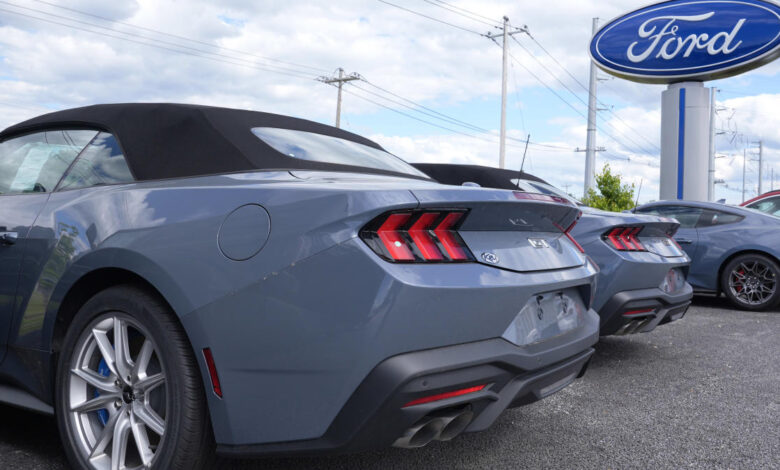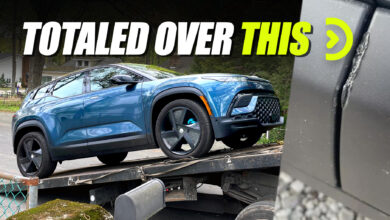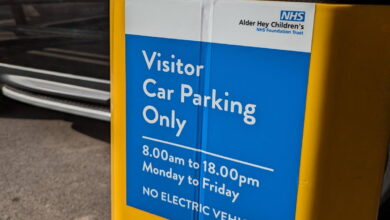EV demand saw ‘false signal’ exiting COVID: Ford vice chair

Ford (F) saw May sales grow 11.2%, largely driven by a near 65% boost in hybrid sales from a year ago. Ford Vice Chair and CFO John Lawler joins Yahoo Finance’s Pras Subramanian at Deutsche Bank’s Global Auto Industry Conference to discuss the automaker’s growth trajectory. Lawler is set to transition full-time into the vice chair position in early 2025, to be succeeded by former Lucid (LCID) Chief Financial Officer Sherry House.
“Ford+ strategy is really about focusing in our customers and their needs. And you start to see that really come through in the segmentation we did in that Ford Pro customers are distinct from Ford Blue customers, which are distinct from our electric vehicle customers and how we’re progressing our strategies in each of those spaces, how we’re providing them value, choice, and we’re moving the business forward,” Lawler explains.
He adds that Ford remains in a strong position as the company is third in the US in hybrids, with sales projected to grow 40% this year. Lawler notes that despite slowing demand for EVs, “there was a false signal coming out of COVID, is how quick the demand was going to grow. And that was because the early adopters, they were really excited about having the choice of electric vehicles. Then we get to the early majority. They’re not willing to put up with some of the other issues that you might have with an EV around range, etc, like those types of things. So choice is important and it’s coming through where you have hybrids.”
Lawler states s that Ford has plans to improve its performance in the EV space with its second generation of vehicles, hoping to “gain traction” from new costs and performances of electric vehicles.
Catch up on Yahoo Finance’s exclusive interview with Ford CEO Jim Farley.
For more expert insight and the latest market action, click here to watch this full episode of Morning Brief.
This post was written by Melanie Riehl
Video Transcript
Ford reporting sales growth of over 11% in the month of May, driven by a nearly 65% boost in hybrid sales from a year ago.
But with overall electric vehicle sales raising concerns about a possible slowdown, what does this mean for the auto giants moving forward?
Yahoo Finance’s pro Superman is standing by live in living colour at Deutsche Bank’s global auto industry conference with Ford Vice chair John Lawler for more.
Hey, Ross.
Hey, thanks, Brad.
Yeah, we are here at the Deutsche Bank Global Autos conference and John Waller, New Ford vice chair here.
Congratulations on the new role.
So I know you’re gonna be presenting soon.
Here, give us some updates on what you’re going to be talking about here.
What are some of the new projections?
Potentially for Ford right now, going into 2024.
Well, we had a good start to the year with Q one, and we’ll be talking about where we’re headed with the business.
You know, Ford plus strategy is really about focusing in our customers and their needs, and you start to see that really come through in the segmentation we did in that Ford Pro customers are distinct from Ford Blue customers, which are distinct from our electric vehicle customers and how we’re progressing our strategies in each of those spaces how we’re providing them value choice, and we’re moving the business forward.
You know, you guys had may sales recently.
Very strong month.
Both Not just ice traditional ice vehicle, but also hybrid.
And let’s how about hybrids?
Did you guys envision that?
You know, a year ago we were talking to you guys at the delivering four plus, uh uh, conference EB is a big push.
Look at hybrid sales.
How do you explain that?
Yeah.
So when you think about hybrids with Ford, we’ve been in hybrids for over 20 years.
We’re number three in the US in hybrids right now.
Now, our hybrid sales grew 40%.
They’re gonna grow 40% this year.
You can’t just turn that on with a switch.
So all the narrative and hype had been around EVs.
But we never walked away from hybrids.
We always had those in their cycle plan.
They were always funded.
And you’re seeing that now.
Is the demands increased?
We have the capacity to provide, uh, for consumers and you’re seeing that take place.
So we’re really pleased about our our our choice that we have for customers across gas hybrid as well as electric vehicles.
I think the maverick in particular has been the sort of a focal point here with the co.
Uh uh uh compact, sort of a pick up, but then also being provided with hybrid power, which I think was interesting when it came out pivoting to EVs.
Now, so we’re also seeing, you know, we’ve we’ve seen the EV sort of demand story kind of slow down a bit, but EV sales into it for Ford.
Quite strong.
Still, what’s your kind of take on that?
And how do you kind of bridge the gap to when those vehicles are profitable?
Right.
So the way we think about EVs, it’s not a matter of if it’s when and how fast.
And so we did see a slow down relative to what people expected, but I think there was a false signal coming out of covid is how quick the demand was gonna grow.
And that was because the early adopters they were really excited about having the choice of vehicles, electric vehicles, then we get to the early majority, they’re not willing to put up with some of the other issues that you might have with an around range et cetera, like those types of things.
So choice is important, and it’s coming through where you have hybrids where you have plug in hybrids.
Other technologies are coming along as well that I think, will help that transition.
So I think you’re going to see the growth continue.
It’s going to be a little bit slower than what we’ve seen in the past now.
Course, for us, getting to profitability is key.
With our segmentation, you can see exactly how we’re performing in the space, and we have plans to improve that primarily with our second generation of vehicles, where we’ll see step function, changes in cost and performance of the vehicles.
And that’s where we think we’ll really start to gain traction from a business standpoint for our electric vehicles.
So really profit may come in the second gen software defined type of exactly so the second gen vehicles.
Not only will the software, uh, capability of those be so they’ll be connected digital devices, but as well as the cost structure of those vehicles is going to improve dramatically through battery technologies, efficiency of design, et cetera.
Because our first generation vehicles to get the market quick, we converted gas vehicles into electric vehicles.
These are ground up platforms designed specifically to be EVs.



